Frame Counter
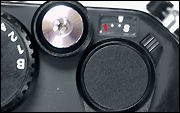 |
 |
The frame counter has indications of S, 1, 2, 4, 6 and up to 36 in even numbers. Frames of odd numbers are indicated by dots between the even numbers. |
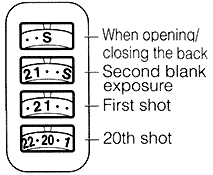 |
Even if there is no film in the camera, the frame counter is operative and advances by a single frame every time you wind the advance lever. After frame 36, the counter will not operate even if you wind the film advance lever; film will be advanced, however, up to the actual end of the film roll. The frame counter is automatically reset to "S" when the camera back is opened. |
Depth-of-Field Preview Lever When you press the Depth-of-Field preview lever toward the camera body, the lens is stopped down to the specified aperture setting, enabling you to check the depth of field through the viewfinder. When checking the depth of field with an Ai-type lens attached to the camera, press the depth-of-field preview lever fully. Release the lever before you shoot.
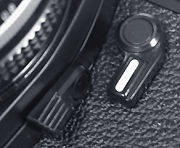 |
Note: When you press the lever, the image in the viewfinder is darkened according to the specified lens aperture (when largest aperture is used, the image stays bright). You will notice there will be a significant clearer in front and behind of the subject in focus as the lens is stopped down further to smaller apertures (while the viewfinder will gradually darken). |
With a special lens (PC lens or bellows attachment/Extension Rings/Tubes for close-ups that do not have a direct meter coupling with the camera), stop-down metering is always made. Note: check their compatibility, some older versions of these rings and bellow attachment cannot be used.
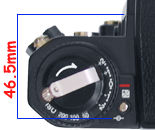 |
Film-Plane Indicator The |
Accessory
Shoe
and Sync-Cord (PC)Terminal
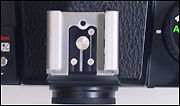 |
Accessory Shoe A Nikon cordless-type Speedlight can be connected only by attaching it to the accessory shoe. This accessory shoe is equipped with a safety lock mechanism (a lock hole) to prevent slippage. When a compatible Nikon speedlight is used, the flash ready light will lit inside the viewfinder to indicate flash charged and exposure status. |
Sync-Cord Terminal This camera has a sync-cord terminal (1) (with a screw to prevent slippage). To use a sync-cord, connect it to this sync cord terminal (X contact only available as sync contact).
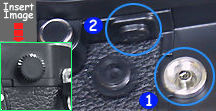 |
Older cable type flash units which don't have proper flash contact can be used. Just next to the Sync terminal is the flash exposure compensation button for auto TTL flash operation (refer to chapter on flash photography that followed). |
In many cases, when you are more familair with flash photography, the PC terminal can also be used in accordance with multiple flash setups. The Sync terminal is supplied with a rubberised cap as protective gear.
Steps of Advanced Photography
Though you can shoot easily and get good results just relying on Auto Exposure, we will hope that you will learn to use advanced techniques and take advantage of the wonderful capabilities your camera offers.
Flash Photography
AE-Lock Photography
Self-Timer Photography
Multiple-Exposure Photography
Flash Photography
One of the
main attraction of FM3A is the incorporation of TTL/OTF* flash
exposure control in the camera. This has enhance and opened up a lot of photographic
possibilities with more positive and assuring results in a wide scope of flash applications.
The FM3A retains the fast maximum sync speed of 1/250 sec. found in older FM2n and
it is very useful for - Not only when shooting in a dark place, but even in daytime
syncrosunlight shooting (most called it as "fill flash"). It is convenient
to use the flash for supplementary lighting to enlarge the shooting range, such as
when the subject is too dark because of rear lighting or a bright background. Applicable
Speedlight and shooting situation:
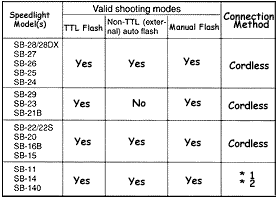 |
Flash attachments from Other 3rd Party Manufacturers |
*1
When a standard TTL flash is used, the SC-23 standard TTL flash cord is required
for connection.
*2 When you shoot in A or M mode, use the SU-2 in combination with the SC-13 to connect
the SB-11 or SB-14, or use the SU-3 with the SC-13, or use the SC-15 with the SC-11
or AS-15 to connect the SB-140.
* TTL/OTF flash stands for "THROUGH THE LENS, OFF THE FLM PLANE" or sometimes just referred as "TTL Flash". It is system first pioneered by Olympus designed to obtain correct exposure for the main subject by firing the flash regardless of the ambient light. This may cause an unnatural balance between the brightnessof the main subject and that of the background. In this case, a separate metering cell is positioned at the base of the mirror box, facing backward to the shutter curtain measuing light refleced ffrom the actual film surface to calculate exposure and the camera internal circuitry will instruct the metering circuit cut off power output of the flash when"sufficient" light intensity is obtained. Thus, an "ideal" flash exposure is achieved. This method has expenaded many possiblities (such as multiple flash setup, macro/closeup work etc.) in flash phtography as less calculation is required.
Lighting
/ Blinking
of the Flash Ready Light
Inside the Viewfinder
The ready light is built into the viewfinder and enables you to check the status
of the Speedlight while looking through the viewfinder.
Lit: The LED of ready light turns on when the Speedlight is fully charged and ready to flash. The ready light does not light in Bulb mode or if the camera's battery is (batteries are) exhausted. |
Blink: When underexposure is likely with the full-flash output of the Speedlight, the ready light blinks for approx. 3 seconds as a warning soon after firing. In this case, shoot again after checking the focus distance, aperture setting, range of flash shooting distance*, etc. The ready light will also blink as a warning if the shutter speed is set between 1/ 500 and 1/4000 second. Select a shutter speed below 1/250 second.
* Flash-shooting distance range is range in which the proper exposure can be obtained in flash photograph. The higher the film sensitivity, the wider the range, and vice versa. The wider the lens aperture, the wider the range, and vice versa. Pictures must be taken within the flash shooting distance range.
An original
effort by the Nikon to adopt some technology from development of flash photography
on other automated Nikon SLRs. The TTL flash function automatically controls the
level of illumination of the flash by checking the reflectance of the flash from
a subject.
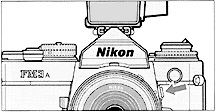 |
However, if a subject is small and far in the background, such that its reflectance is underestimated, the level of illumination may become unnecessarily high, causing overexposure. |
In such a situation, shooting with the TTL flash-compensation button held pressed can reduce the level of illumination and provide better exposure. When you fire the flash for extra illumination on a main subject with a bright background, you can reduce the level of illumination to achieve desirable exposure by using the TTL flash-compensation button.
| Example: Before Flash Exposure compensation | Example: After Flash Exposure compensation |
When you press the TTL flash-compensation button, the exposure is compensated by -1 EV (for less compensation) automatically. The flash-exposure compensation function of the flash attachment cannot be used. |
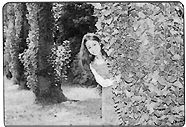 |
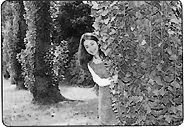 |
Basically, flash-exposure compensation is a light-control system to automatically control the illumination level of flash properly according to the ambient brightness is called flash exposure. Flash-exposure compensation is a function to increase/decrease this automatic-level-control range. See illustration above to see effect before and after an falsh flash-exposure compensation operation.
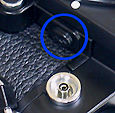 |
Note that, when activated, there is no indication regarding the flash-exposure compensation in the viewfinder. Note: IF exposure compensation is made with the camera, flash-exposure compensation is also made. If the flash-compensation button is used in combination, the exposure is compensated by another -1 EV . |
Procedure for TTL flash photography
Applicable film speeds for TTL auto flash are ISO 12 to ISO 1000. The flash-sync speed is 1/250 second or lower. In Aperture-Priority Auto (A) mode, the speed is automatically set to 1/250 second. Note: When you use a Medical lens, set it to 1/125 second or lower. An example is given below for when the Nikon SB-27 Speedlight is attached to the camera. For details, refer to the manual for your Speedlight,
 |
1. Set the exposure mode. Set it to "A" or "M" with |
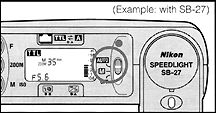 |
2. Set the mode switch of the Speedlight to AUTO. |
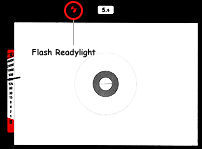 |
|
3. Confirm that the |
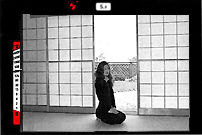 |
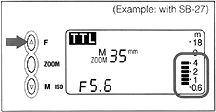 |
Press the "F" button to obtain the same value as the aperture setting on the lens. Lightly press the shutter release button and check that the ready light is lit, then shoot. |
5.Make sure the subject is within the range* of flash-shooting distance, then shoot. |
||
<ISO 100>:
Equation to obtain the camera-to-subject distance:
D (camera-to-subject distance) = GN (guide number) / F (aperture)
Equation to obtain the aperture:
F (aperture) Number) = GN (guide number) / D (camera-to-subject distance)
Guide
number is often
used to determined how "powerful" a particular flash is. It is used as
a standard value to numericaliy show the illumination level (ISO 100. m, 20 degreeC
/ 68 degree F) of flash. The value is indicated in units of GN (ISO 100-m).
Note: If the ready light
blinks for approx. 3 sec. immediately after firing the flash, check the camera-to-subject
distance, aperture setting, and range of flash-shooting distance, and shoot again.
Previous | NEXT | 6/8 AE-Lock (Auto-Exposure Lock) Photography, Self-Timer Photography, Multiple-Exposure Photography, Additional Information on Shutter Speed and Aperture Setting
| Back | Index Page of Instruction Manual Section of Nikon FM3A
| Other Issues relate to Nikon
FM3A | < Index Page
>
| Instruction Manual for Nikon FM3A |
| Technical Specification | Main
Reference Map
|
Standard
production Nikon FM Series models:-
Nikon FM | Nikon FM2 | Nikon FM2n | Nikon FM10 | Nikon FM3a |
Known
variants:-
Nikon
FM Gold
| Nikon
FM2/T
| Nikon
FM2N Tropical Set
| Nikon
FM2/T Limited Edition
| Nikon
FM2N LAPITA
|
Nion
FM2n Millennium 2000
| Message Board | for
your favourite Nikon
FM Series SLR models
| Message
Board | for your Nikon
Optics in a shared environment
| Message Board | Specifically for Dispose or Looking for Nikon/Nikkor
Photographic Equipment
| Back | Main Index Page of Nikon FM series Bodies
Shared Resources: MD-11 | MD-12 | Focusing Screens | Titanium Shutter | ORIGINAL dedicated Flash Units -SB-16 | SB-15 | SB-10 or other Options | Databack | Nikkor lens mount (related info)
Others:- Nikon AF-TTL Speedlights
| SB-20 (1986)
|
SB-22
(1987)
| SB-23 | SB-24 (1988) |
SB-25 (1991/2) |
SB-26 (1994)
| SB-27(1997)
| SB-28 (1997) |
Nikon
SB-29(s)
(2000) |
Nikon
SB-30
(2003) |
Nikon
SB-600
(2004) |
Nikon
SB-800 (2003)
(updated)
Nikon AF-TTL Speedlight DX-Series: Nikon SB-28DX (1999)
| SB-50DX (2001) |
SB-80DX
(2002)
(updated)
Nikon
BC-flash Series |
Original Nikon Speedlight
SB-2
| SB-3
| SB-4
| SB-5
| SB-6
| SB-7E
| SB-8E
| SB-9
| SB-E
| SB-10
SB-11
| SB-12 | SB-14 | SB-140 UV-IR| SB-15 | SB16A | SB-17 | SB-18, SB-19 | SB-21A (SB-29) Macro flash | Flash Accesories | SF-1
Pilot Lamp
Instruction
Manual: Nikon FM (HTML | PDF) | Nikon FM-10 (HTML) | Nikon FM2n's
User's Manual
available only in HTML format (6
parts) | Nikon FM3A (HTML)
Specifications: Nikon FM, FM-10, FM2, FM2n and FM3A
Main Reference Map: (HTML) Nikon FM, FM2, FM-10, FM2n (Applicable
to FM2T, FM2 "Year of the Dog"; Millennium 2000") and FM3A
| Nikon F | Nikon F2 | Nikon F3 | Nikon F4 | Nikon F5 | Nikon F6 | Nikkormat / Nikomat | Nikon FM | Nikon FE/ FA | Nikon EM/FG/FG20 | Nikon Digital SLRs | Nikon - Other models |
Nikon Auto Focus Nikkor lenses:- Main Index Page
Nikon Manual Focus Nikkor lenses:- Fisheye-Nikkor Lenses - Circular | Full Frame |
Ultrawides Lenses - 13mm15mm18mm20mm | Wideangle Lenses - 24mm28mm35mm | Standard Lenses - 45mm 50mm 58mm | Telephoto
Lenses - 85mm105mm135mm180mm & 200mm | Super-Telephoto Lenses - 300mm 400mm 500mm 600mm 800mm 1200mm |
 Index Page |
Special
Application lenses: Micro-Nikkor Lenses - 50mm~55mm -60mm 85mm -105mm 200mm Micro-Zoom 70-180mm Perspective Control (PC) - 28mm 35mm PC-Micro 85mm Dedicated Lenses for Nikon F3AF: AF 80mm f/2.8 | AF 200mm f/3.5 EDIF Depth of Field Control (DC): 105mm 135mm Medical Nikkor: 120mm 200mm Reflex-Nikkor Lenses - 500mm 1000mm 2000mm Others: Noct Nikkor | OP-Nikkor | UV Nikkor 55mm 105mm | Focusing Units | Bellows-Nikkor 105mm 135mm Nikon Series E Lenses: 28mm35mm50mm100mm135mm | E-Series Zoom lenses: 36~72mm75~150mm70~210mm |
MF Zoom-Nikkor Lenses: 25~50mm | 28~45mm | 28~50mm | 28~85mm | 35~70mm | 36~72mm E | 35~85mm | 35~105mm | 35~135mm | 35~200mm | 43~86mm | 50~135mm | 50~300mm | 70~210mm E | 75~150mm E | 80~200mm | 85~250mm | 100~300mm | 180~600mm | 200~400mm | 200~600mm | 360~1200mm | 1200~1700mm
Tele-Converters: TC-1 | TC-2 | TC-200 | TC-201 | TC-300 | TC-301 | TC-14 | TC-14A | TC-14B | TC-14C | TC-14E | TC-16 | TC-16A | TC-20E
Recommended links to understand more technical details
related to the Nikkor F-mount and production Serial Number:
http://rick_oleson.tripod.com/index-153.html by: my
friend, Rick Oleson
http://www.zi.ku.dk/personal/lhhansen/photo/fmount.htm by: Hansen,
Lars Holst
http://www.mir.com.my/rb/photography/hardwares/nikonfmount/lens2.htm
http://www.photosynthesis.co.nz/nikon/serialno.html
W A R N I N G: The New G-SERIES Nikkor lenses have no aperture ring on the lens, they CANNOT ADJUST APERTURES with any of these manual focus Nikon FE series SLR camera models; please ignore some portion of the content contained herein this site where it relates.
|
Back | Main Index Page of Nikkor Resources
|
Back | Main Index Page of Pictorial
History of Nikon SLRs
| Message Board | for your Nikkor optics ("shared" because I do wish some of you to expose to other's perspective as well. Isn't it a sad sate to see photography has to be segmented into different camps from the use of various labels)
about this photographic web site
Home - Photography in Malaysia |
Credit: To all the good people who has contributed their own experience, resources or those who are kind enough granting us permission to use their images appeared in this site. Mr. MCLau®, who has helped to rewrite some of the content appeared this site. Chuck Hester® who has been helping me all along with the development of all these Nikon websites;LarsHolst Hansen, 'Hawkeye' who shares the same passion I have; Ms Rissa, Sales manager from Nikon Corporation Malaysia for granting permission to use some of the official content; TedWengelaar,Holland who has helped to provide many useful input relating to older Nikkor lenses; Some of the references on production serial numbers used in this site were extracted from Roland Vink's website; HiuraShinsaku from Nikomat Club Japan. t is also a site to remember a long lost friend on the Net. Note:certain content and images appeared in this site were either scanned from official marketing leaflets, brochures, sales manuals or publications published by Nikon over the years and/or contribution from surfers who claimed originality of their work for educational purposes. The creator of the site will not be responsible for may discrepancies arise from such dispute except rectifying them after verification."Nikon", "Nikkormat", "Nippon Kokagu KK" & "Nikkor" are registered tradename of Nikon Corporation Inc., Japan. Site made with an Apple IMac.
